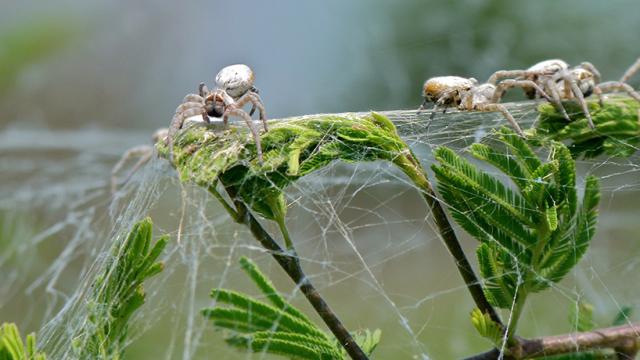Spiders are typically thought of as solitary creatures that don’t partake in social pleasantries unless it has something to do with mating. But as new research shows, the African velvet spider is an exception to this rule. Mother spiders are assisted by closely-related virgin females who, in addition to engaging in child-rearing tasks, offer themselves up as a sacrificial meal for the spiderlings.
Velvet spiders. (Image: Bernard Dupont/Flickr)
Velvet spiders, or Stegodyphus dumicola, are social spiders that live in large communal nests consisting of hundreds of members. These arachnids are almost ant-like in their behaviours, working together to catch prey, defend the nest, and share parenting responsibilities (a behaviour known as allomaternal care). In this species, unmated (virgin) spiders, in addition to tending to newborns and regurgitating food for them, eventually offer their bodies — or more accurately, their internal organs — as a feast for the developing spiderlings, according to new research published in Animal Behaviour.
These spiders live for only a year, and reproduce just once during their brief lifetimes. Only 40 per cent of female velvet spiders reproduce, “and mothers show extended maternal care including eggsac tending, regurgitation feeding and matriphagy, in which they are consumed by the offspring,” according to the study. But in this species, the self-sacrifice isn’t reserved for just the mothers. In what would appear to be a violation of the so-called “selfish gene” hypothesis, some non-parents (that is, virgin females) also partake in the gruesome activity of matriphagy.
Aarhus University’s Trine Bilde, who headed the new study, appropriately describes it as an “extreme” form of allomaternal care whereby the spiders’ “reproductive interests are aligned between closely related virgins and mothers”.

A velvet spider nest. (Image: Bernard Dupont/Wikimedia)
For the new study, Bilde and her colleagues sought to understand the degree to which virgin females participate in maternal care, and how their foraging behaviours might differ from reproductively active female spiders. To that end, the researchers bred velvet spiders in the lab and segregated them into groups, each consisting of two mothers, three virgin females, and some hungry spiderlings.
By studying the spiders’ behaviour, the researchers found that female virgin spiders “contributed to all aspects of extended brood care”, including regurgitation, feeding and matriphagy — an evolutionary adaptation known as cooperative breeding. But the researchers did notice some slight behavioural differences as well; the virgin females participated less in brood care, and more in prey attack than the mothers.
So why the heck would non-mothers voluntarily offer themselves up as a meal, and what does Bilde mean when she says their “reproductive interests are aligned”?
The reason has to do with the social makeup of this species and the high degree of genetic relatedness among the members of a nest. Like ant and bee colonies, these spiders can be seen a kind of “superorganism”, whereby collective self-preservational behaviours are favoured. In this case, the high relatedness among the nestmates (a form of kin selection), plus the low chances of future reproduction, means both parties benefit from the arrangement. This “extreme allomaternal care by virgin helpers can be considered an adaptation to cooperative breeding in social spiders,” conclude the authors in the study.
But this behaviour makes sense for another reason as well. As biologist Mor Salomon told New Scientist, prey is quite scarce in the arid African landscapes where this animal lives. So in addition to preserving closely related genomes, cannibalism also provides a much-needed meal for the next generation of velvet spiders. It may be gruesome, but that’s the way nature rolls sometimes.
